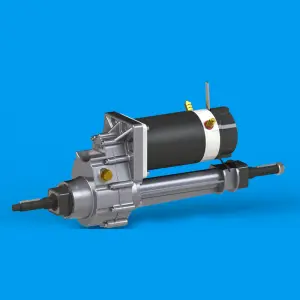The transaxle final drive is a key component in the vehicle transmission system. It plays an important role in transferring power from the engine to the wheels, ultimately determining the vehicle’s speed and performance. Understanding the transaxle final drive and its functions is crucial for car owners and car enthusiasts alike. In this article, we’ll take an in-depth look at the concept of a transaxle, its final drive, and its importance in the overall operation of a vehicle.
What is a transaxle?
The transaxle is a major mechanical component in front-wheel drive and some rear-wheel drive vehicles. It combines the functions of transmission, axle and differential into one integrated unit. This design allows for a more compact and efficient layout because the transaxle is located directly below the engine and serves as the link between the engine and the drive wheels.
The transaxle is made up of several key components, including the transmission, differential, and final drive. The transmission is responsible for shifting gears and transferring power from the engine to the transaxle. The differential allows the wheels to rotate at different speeds when cornering, ensuring smooth and stable handling. The final drive, which is the focus of this article, is the final component in the transaxle system and is responsible for further reducing the speed of the transaxle’s rotational output before it reaches the wheels.
Learn about transaxle final drives
The transaxle final drive, also known as the differential final drive, is the final stage in the power transmission process within the transaxle. Its main function is to further reduce the speed of the power from the transaxle before transferring it to the wheels. This reduction in speed is necessary to match the rotational speed of the wheels to the speed of the vehicle and the output of the engine.
The final drive consists of a set of gears, usually a ring gear and a pinion, that work together to achieve the necessary reduction. The ring gear is connected to the differential, while the pinion gear is driven by the output shaft of the transaxle. As the pinion rotates, it drives the ring gear, further reducing speed before power is transferred to the wheels.
The Importance of Transaxle Final Drive
The transaxle final drive plays a vital role in the overall performance and efficiency of the vehicle. It reduces the rpm of the transaxle power, ensuring that the wheels receive the appropriate torque to propel the vehicle forward. This is especially important when accelerating and climbing steep hills, as it allows the vehicle to maintain speed and power without putting undue stress on the engine.
In addition, the final drive also contributes to the vehicle’s fuel efficiency. By optimizing the speed of the wheels, the final drive helps ensure the engine operates in its most efficient range, reducing fuel consumption and emissions. This is especially important for modern vehicles, where fuel efficiency and environmental impact are key considerations for manufacturers and consumers.
In addition to its functional importance, the transaxle final drive plays an important role in the overall driving experience. By maintaining proper speed and torque at the wheels, the final drive contributes to smooth and responsive acceleration, as well as stable and predictable handling. This is vital to ensuring a comfortable and enjoyable driving experience for vehicle occupants.
Maintenance and care
Like any mechanical component, the transaxle final drive requires regular maintenance and service to ensure optimal performance and longevity. Routine inspections and fluid changes are critical to preventing gear and bearing wear within the final drive. Additionally, addressing any unusual noise or vibration coming from the transaxle can help identify potential issues with the final drive before they escalate into more serious problems.
It’s also important to follow the manufacturer’s recommended transaxle and final drive service intervals, as neglecting these components can lead to premature wear and potential failure. By being proactive with maintenance and promptly resolving any issues, vehicle owners can ensure that the transaxle final drive continues to operate smoothly and reliably throughout the life of the vehicle.
Upgrades and performance enhancements
For car enthusiasts and performance-focused drivers, the transaxle final drive can also be a target for upgrades and enhancements. Aftermarket gear sets and limited-slip differentials are popular upgrades that can improve acceleration, traction, and overall performance. These upgrades change gear ratios and differential behavior, allowing for more aggressive acceleration and improved handling characteristics.
It is important to note, however, that caution should be exercised when modifying a transaxle final drive, as improper upgrades or installations can cause drivability issues as well as potential damage to other driveline components. When considering any modifications to the transaxle final drive, it is critical to consult with an experienced professional and follow the manufacturer’s guidelines.
In summary, the transaxle final drive is a critical component in the drivetrain of front-wheel drive and some rear-wheel drive vehicles. Its role in reducing transaxle power before it reaches the wheels is critical to maintaining vehicle performance, efficiency and the overall driving experience. Understanding the function and importance of a transaxle final drive can help owners and enthusiasts understand its importance and make informed decisions about maintenance and potential upgrades.
Post time: Aug-14-2024


